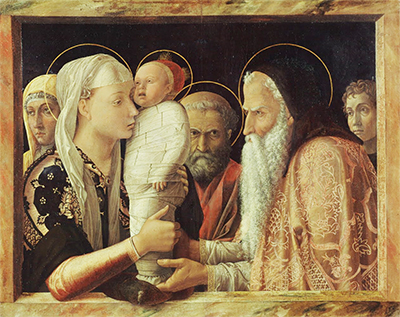Presentation at the Temple is an example of Andrea Mantegna's early work, from his time in Padua. The exact date of the early Renaissance painting is unknown, but estimates vary from 1453 to 1460.
During this time, Mantegna allied himself through marriage to the artist Giovanni Bellini, who subsequently produced a very similar painting also titled Presentation at the Temple. Comparison of the two paintings illustrates Mantegna's skill at using light and shadow to produce depth and perspective in his work. The painting is on wood, in the artist's preferred medium of tempera on canvas. The scene is surrounded by a marble frame, with the Virgin Mary in the foreground holding the Christ child. A bearded priest is reaching for the infant, with Joseph in the centre of the scene looking on. The marble ledge at the bottom of the painting is used as a device to bridge the space between the subjects and the viewer.
Mantegna uses his favoured technique of trompe l'oeil to make Mary's arm, and the cushion on which the Christ child rests, appear to thrust out of the painting. This serves to emphasise the space and depth behind the group, as well as thrusting the child into the viewers space. Here we can also see a more subtle example of Mantegna's skill with perspective and foreshortening, as the infant Christ is seen at an angle, leaning back towards the background. The Virgin Mary, the priest, Joseph and the Child all have an aureola, indicating their status as sacred figures. There is strong belief that, in the figure emerging from the shadow to the right of the painting, Mantegna has painted himself. Artists have done this occasionally over the centuries, although they would often leave a little room for discussion by not explicitly telling anyone of their own inclusion, leaving the rest of us to debate it.
The woman to the far left is believed to be his wife, Nicolosia Bellini. These two figures have no aureola, as they are not sacred, and appear to play no part in the scene, instead looking to the distant left. The painting will be on loan to the National Gallery in London from March to July 2018, where it will displayed alongside the work of the same name by his brother in law, Giovanni Bellini, allowing visitors to directly compare these two remarkable works of art. After July, the Mantegna painting will return to it's home in the Gemäldegalerie in Berlin, Germany. That fine establishment features one of the finest collections in all of Europe and is particularly strong on local artists, from the nation of Germany and also some surrounding countries such as the Netherlands, Belgium and Switzerland who have each contributed some important artists of their own in previous centuries.




